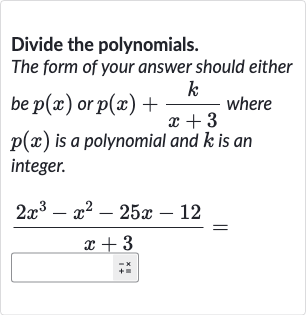Full solution
Q. Divide the polynomials.The form of your answer should either be or where is a polynomial and is an integer.
- Set up long division: Set up the long division.We will use polynomial long division to divide by .
- Divide first term: Divide the first term of the dividend by the first term of the divisor.Divide by to get .Write above the division bar.
- Multiply divisor and result: Multiply the divisor by the result from Step ..
- Subtract result from dividend: Subtract the result from Step from the dividend..
- Bring down next term: Bring down the next term of the dividend to prepare for the next division step.We now have .
- Divide first term of new dividend: Divide the first term of the new dividend by the first term of the divisor.Divide by to get .Write above the division bar, next to .
- Multiply divisor and result: Multiply the divisor by the result from Step ..
- Subtract result from new dividend: Subtract the result from Step from the new dividend..
- Bring down next term: Bring down the next term of the dividend to prepare for the next division step.We now have .
- Divide first term of new dividend: Divide the first term of the new dividend by the first term of the divisor.Divide by to get .Write above the division bar, next to .
- Multiply divisor and result: Multiply the divisor by the result from Step ..
- Subtract result from new dividend: Subtract the result from Step from the new dividend..
- Write final answer: Write the final answer.Since there is no remainder, the result of the division is the polynomial written above the division bar: .

